|
|
There are eight workshops related to Funbook 2. These workshops can be done without using the Funbook, but the Funbook pages enhance the workshop experience. Students can do Funbook pages as a workshop introduction or as a follow-up activity.
For each workshop listed, read the workshop description. If desired, you can click to get an outline of what to do at the workshop. And decide if you want to have the suggested “give-aways” so kids can do more math at home.
|
|
 |
1. Amanda Bean's Amazing Dream, by Cindy Neuschwander
The book: Amanda Bean loves to count. Everywhere she looks she sees things that she feels compelled to count. Her teacher tells her that multiplication would be a faster way to count, but Amanda persists. Then one night she has a dream where she can't count fast enough….
The math activity: Make multiplicative arrays (items arranged in rectangles). Repeat the process using blocks and graph paper. See how the multiplication chart was derived. Use it for skip counting, or to find multiplication facts.
Take-home item: A multiplication chart and a starter set of 20-30 linking cubes. |
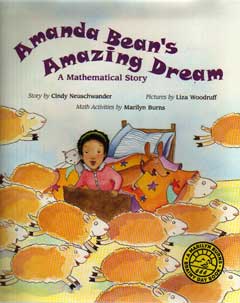 |
|
|
 |
2. Chrysanthemum by Kevin Henkes
The book: Chrysanthemum has always loved her name – until she goes to school and the other children tease her about it. The book provides an opportunity to talk about the effects of teasing, and to investigate the special features of everyone’s name.
The math activity: Count the letters in a collection of names. Graph the results on a lineplot. Learn how to skip count and add, on a calculator. Then use calculators to find the value of your name, if A=1, B=2, etc.
Take-home item: A dollar store calculator! |
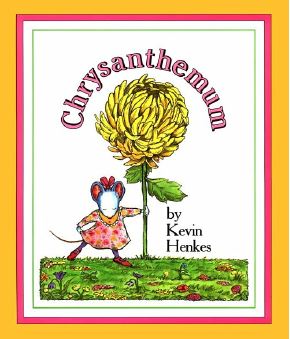
|
|
|
 |
3. Measuring Penny, by Loreen Leedy
The book: Lisa's class gets a homework project: Find something to measure andmeasure it as many ways as you can. Lisa decides to measure her dog, Penny. Be impressed when you see how many ways Lisa finds to arrive at different kinds of measurements!
The math activity: Measure stuffed animals – as many ways as you can think of! Record measurements and share with others. (Ideally, try and get children to measure one of their own favorite stuffed animals.)
Take-home item: A tape measure, or a miniature stuffed animal to measure. |
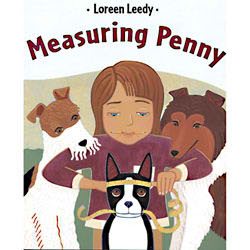
|
|
|
 |
4. Picture Pie, by Ed Emberley
The book: This is an art book. See how to make pictures using fractional parts of a circle. All pictures in the book are made with halves, fourths and eighths of a circle. Suggestions are offered about how to turn pictures into greeting cards, calendars, bulletin boards, book covers, etc.
The math activity: Play a game that requires filling whole circles with halves, fourths, and eighths. Then select one of the fish from the book, and make it using cutouts of fractional parts of a circle. Glue fish on blue paper. Use sequins for eyes. (Put all the fish together to make a bulletin board that looks like a big aquarium.) Keep track of how many pieces you used for each fish. Challenge older children to find the total value for each fish, by adding the fractions.
Take-home item: The fraction game board, and a fraction die to play the game. Goldfish crackers (optional). |
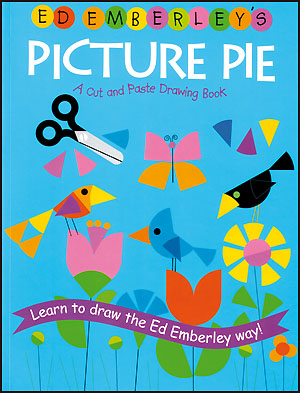
|
|
|
 |
5. A Quarter from the Tooth Fairy, by Caren Holtzman
The book: A boy gets a quarter from the tooth fairy. He buys things and then returns them. Each time he gets his money back, a different combination of coins is used to add to 25 cents.
The math activity: How many different ways can you make 25 cents? Children use real coins and record all the possible combinations. Then they sort through piles of quarters to identify state quarters, and record the states that they have found. Record group results on a large size map of the U.S.
Take-home item: A quarter coin folder to start your own quarter collection. |

|
|
|
 |
6. Spaghetti and Meatballs for All, by Marilyn Burns
The book: Mr. and Mrs. Comfort decide to have a family reunion. She will set the tables; he will make the dinner. The plan is to have 32 dinner guests sitting at 8 tables, 4 to a table. But when the guests arrive, they push the tables together and there are not enough places for everyone to sit! What went wrong? How will they resolve the problem? |
The math activity: Not all pasta is spaghetti. Make a big bowl of (dry) mixed pasta. Have each child grab a big handful of pasta. Tell them to "graph the kinds you got."As you read the book, focus on the concepts of area and perimeter. (As tables were pushed together, they lost perimeter!) Make pentomino shapes and talk about their area and perimeter, too.
Take-home item: Take home the pasta to make a spaghetti snack. (If you can find them at reasonable cost, give out small snack-size cans of spaghetti and meatballs!) |
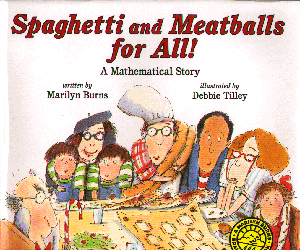
|
|
|
 |
7. The Sundae Scoop, by Stuart J. Murphy
The book: Winnie the lunch lady is helping the children organize a sundae booth for the school picnic. How many kinds of ice cream sundaes can they make? And what happens the day of the picnic when the sprinkles get spilled, the cat knocks over the caramel, and the chocolate ice cream starts to melt? |
The math activity: Use tree diagrams to determine how many sundae combinations are possible for a given number of ice cream flavors, sauces, and toppings. Have children identify their favorite combinations, and make a graph to show which sundaes are most popular.
Take-home item: Have an ice cream party using the combinations shown in the sundae chart! An alternative: Give out coupons to take to a local ice cream store. Yum! |
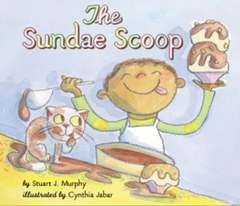
|
|
|
 |
8. Wanda's Roses by Pat Brisson
The book: Wanda finds a thorn bush in an abandoned lot strewn with trash. She is convinced it is a rose bush and proceeds to clear the lot to make a vest-pocket garden. Her neighbors know |
that the mystery bush is a thorn bush. They don't want her to be disappointed. They bring her some rose bushes to plant, and Wanda's rose garden dream becomes a reality!
The math activity: Make tissue paper roses in three colors and combine them in bouquets of 10. What combinations are possible? Make a record. Then think about a plan for Wanda’s garden. Draw an aerial view, or make a miniature garden in a box top, using stickers, cutouts, wrapping paper, other small items.
Take-home item: The paper rose, and a "kit" to make another one (tissue paper, a pipe cleaner and directions). |
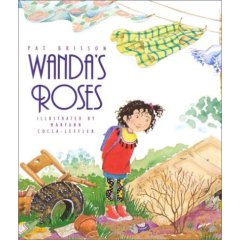
|
|
|
 |